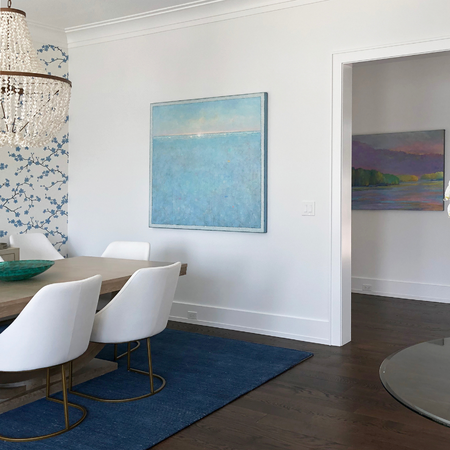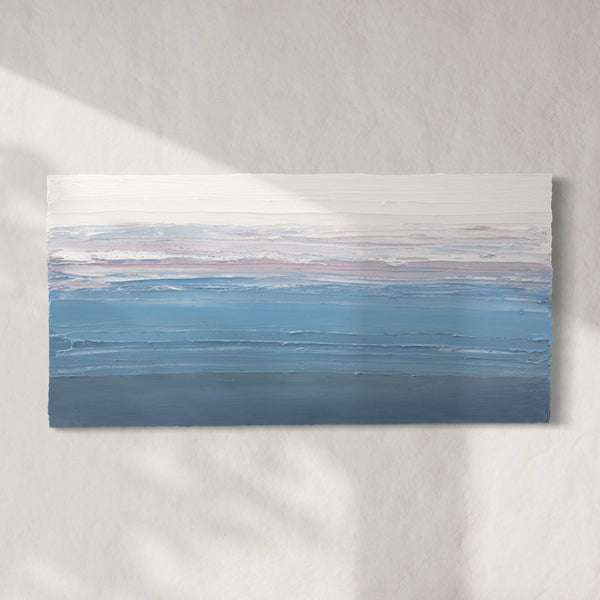This week, we're taking a look at how to hang art in one of the most important rooms in a home: the dining room. It's understandable that we might spend a lot of our art-curating energies on other rooms - the living room with a mantle, or the first-impression-entryway, for example. But the dining room is a crucial space, a space where friends and family gather for hosted meals, holiday get-togethers, and more. So how do you hang art in a dining room, you ask? We'll break it down here, with three things to consider when you start your search.
Go BIG.
One thing about the architecture of a designated dining room is that it will often come with larger, open walls. Dining rooms typically house buffet tables, china cabinets, and other large furniture in them, and those walls are there to accommodate. But even with a buffet, there's half of a blank wall remaining above it. And for those with a more contemporary or minimalist style, who may opt out of a full china cabinet, you're left with big, blank walls. Our suggestion? Go big. Make sure you fill the space. There's nothing more awkward than sitting in a room with blank walls, or massive walls with itty-bitty paintings on them. So fill the room with bigger pieces for a thoughtful, well-designed look.
If you're a die-hard lover of small pieces, that's okay too! Just keep in mind that you'll need more of them to fill those bigger walls well, so try to find varying sizes that you can stack together to create a gallery wall. We love an arrangement of small art on a wall with a fun wallpaper or unique paint color.

(left) An abstract painting by Ned Martin fills a large, open wall in a contemporary dining room. (right) An Elwood Howell painting serves as a focal point on an open wall in a light and airy dining room, drawing on varying shades of blue throughout the design. Designed by Kelly Anne Sohigian.
Express yourself.
A dining room is a space where you host guests. And they're not necessarily the types of guests that are just "popping by" - these are guests who are here to hang out for a while. When choosing artwork for a room like this, you want it to be an expression of you as an individual, a couple, a family. So pick what you love - something that reflects your likes and values. And don't hold back! What's the thing you do at a dining room table (aside from devouring a massive turkey dinner in November, of course)? You talk! Let your artwork be a conversation starter. Let it inspire intrigue and ruffle feathers. As long as you love it, it can be the life of the party.

A modern painting by Abstract Expressionist Stanley Bate ties into the bold red walls in this dining room, while adding a striking appeal to a more traditional space.
 A triptych by Teodora Guererra fills this monochrome dining room with a soft fluidity - a contrast to the otherwise geometric elements of the table and light fixture. While the paintings' greyscale colors blend in with their surroundings, their composition adds liveliness and balance to the room's personality - a clear indication of the owner's own individuality.
A triptych by Teodora Guererra fills this monochrome dining room with a soft fluidity - a contrast to the otherwise geometric elements of the table and light fixture. While the paintings' greyscale colors blend in with their surroundings, their composition adds liveliness and balance to the room's personality - a clear indication of the owner's own individuality.
Let the art be the "finishing touch."
As we mentioned earlier, there's a somewhat standard set of furnishings that most dining rooms have to work with. The table, of course. A buffet, maybe a china cabinet or a console table, a hanging chandelier, or even a little extra standing decor, like a floor plant for example. So your artwork has to fit itself in nicely, and play off of those other pieces. Think of your artwork as the finishing touch - the cherry on top of a gorgeous sundae. It can add unique flair or match perfectly, and should aim to tie the room together.
 (left) An abstract painting by Robert Marchessault hangs above a fireplace in this contemporary dining room, drawing the similar seating colors up. Design by Chris Roughan. Photo by Jane Beiles. (right) A fine art mirror by Alina B fills in a small wall space above wainscoting, adding visual appeal without competing with the surrounding area.
(left) An abstract painting by Robert Marchessault hangs above a fireplace in this contemporary dining room, drawing the similar seating colors up. Design by Chris Roughan. Photo by Jane Beiles. (right) A fine art mirror by Alina B fills in a small wall space above wainscoting, adding visual appeal without competing with the surrounding area.
The wonderful thing about the dining room is that it's a place for people. So it's a room where you can (and should!) let your own personality shine through, and enable others to engage with it. That's a really special thing to be able to accomplish - to have people feel comfortable in a home you've pieced together.
So what's next? Here are a few optional steps on your art collecting journey:
Contact an Art Advisor for a Custom Digital Rendering
Want to learn more about hanging art in different rooms of your home? Check out more posts in our The Art of Hanging Art blog series in the Trends section of our blog.
And as always, feel free to contact us with any questions you may have!




0 comments
Post a comment